jump start AUDI A3 2020 Owner´s Manual
[x] Cancel search | Manufacturer: AUDI, Model Year: 2020, Model line: A3, Model: AUDI A3 2020Pages: 400, PDF Size: 107.47 MB
Page 309 of 400
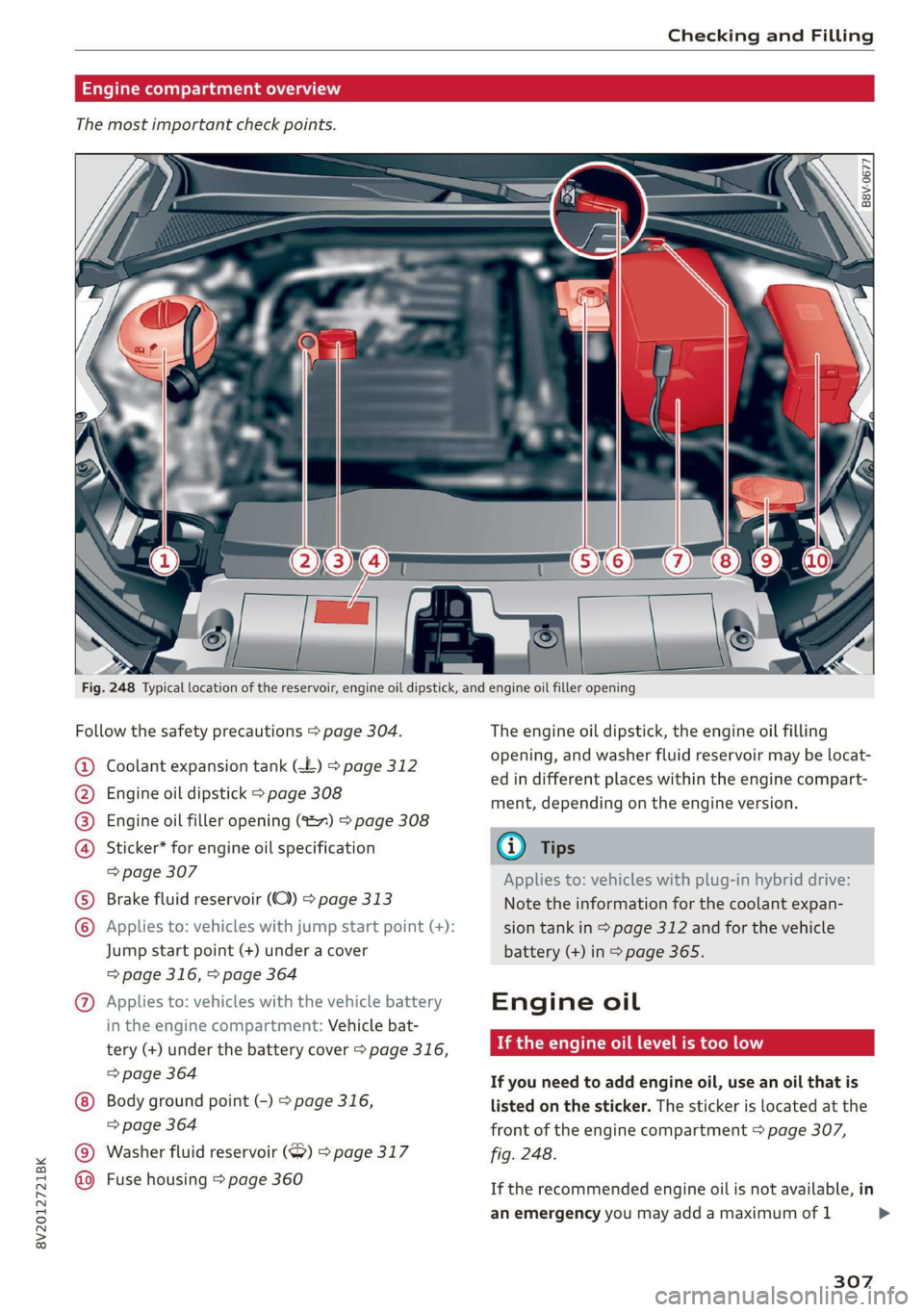
8V2012721BK
Checking and Filling
Engine compartment overvie
The most important check points.
~ R
S| 8
> 2) ao
Fig. 248 Typical location of the reservoir, engine oil dipstick, and engine oil filler opening
Follow the safety precautions > page 304.
Coolant expansion tank (£) > page 312
Engine oil dipstick > page 308
) Engine oil filler opening (27) > page 308
(4) Sticker* for engine oil specification
=> page 307
Brake fluid reservoir (CO) > page 313
Jump start point (+) under a cover
=> page 316, > page 364
@) Applies to: vehicles with the vehicle battery
in the engine compartment: Vehicle bat-
tery (+) under the battery cover > page 316,
=> page 364
(8) Body ground point (-) > page 316,
=> page 364
Washer fluid reservoir (>) > page 317
Fuse housing > page 360
) Applies to: vehicles with jump start point (+):
The engine oil dipstick, the engine oil filling
opening, and washer fluid reservoir may be locat-
ed in different places within the engine compart-
ment, depending on the engine version.
(i) Tips
Applies to: vehicles with plug-in hybrid drive:
Note the information for the coolant expan-
sion tank in > page 312 and for the vehicle
battery (+) in > page 365.
Engine oil
If you need to add engine oil, use an oil that is
listed on the sticker. The sticker is located at the
front
of the engine compartment > page 307,
fig. 248.
If the recommended engine oil is not available, in
an emergency you may add a maximum of 1
307
>
Page 317 of 400

8V2012721BK
Checking and Filling
Battery
eae mee eles)
Because of the complex power supply, all work on
batteries such as disconnecting, replacing, etc.,
should only be performed by an authorized Audi
dealer or authorized Audi Service Facility > A\.
Multiple batteries with different technologies
may be installed in your vehicle:
— Vehicle battery (for example, for starting the
engine, basic power supply) > page 315, Lead
battery or > page 316, Other battery types
— Auxiliary battery (for example, for recuperation
or optional equipment) > page 316, Other bat-
tery types
— Applies to: plug-in hybrid drive: High-voltage
battery (for example, for electric driving)
=> page 96.
Not running the vehicle for long periods of
time
The battery will gradually drain if the vehicle
does not run for long periods of time. To ensure
that the vehicle can still be started, the electrical
equipment will be reduced or switched off
=> page 82. Some convenience functions, such as
interior lighting or power seat adjustment, may
not be available under certain circumstances.
These convenience functions will be available
again once you switch the ignition on and start
the
engine.
Even when electrical equipment is switched off,
the equipment can still drain the battery if the
vehicle is not driven for long periods of time.
Deep draining results in a chemical reaction that
destroys the inside of the battery. The battery
must be charged every month to prevent this
= page 316. Contact an authorized Audi dealer or
authorized Audi Service Facility for more infor-
mation.
Winter operation
Cold weather places higher demands on the bat-
tery. This results in reduced starting ability. Have
the battery checked by an authorized Audi dealer
or authorized Audi Service Facility before cold
weather begins.
ZA WARNING
— All work on the battery or electrical system
in your vehicle can result in injuries, chemi-
cal burns, accidents, or burns. Because of
this, all work must be performed only by an
authorized Audi dealer or authorized Audi
Service Facility.
— Never connect the charging cable or jump
start cable directly to your vehicle battery.
Only use the connections in the engine com-
partment > page 316.
Z\ WARNING
California Proposition 65 Warning:
— Battery posts, terminals and related acces-
sories contain lead and lead compounds,
chemicals known to the State of California
to cause cancer and reproductive problems.
Wash hands after handling.
@) Note
If the vehicle will be parked for long periods
of time, protect the battery against the cold
so that it will not be destroyed by “freezing”
= page 316, Charging the battery.
Lead battery
Explanation of warnings:
© Always wear eye protection.
Battery acid is highly corrosive. Always
wear protective gloves and eye protection.
® Fire, sparks, open flame, and smoking are
@/
aa
forbidden.
A highly explosive mixture of gases can
VN form when charging batteries.
Always keep children away from battery
®) acid and the battery.
Always follow the instructions in the oper-
ating manual.
@) For the sake of the environment
¥ Lead-acid batteries must be disposed of
using methods that will not harm the
315
Page 318 of 400

Checking and Filling
environment. Do not dispose of them in
household trash. They contain harmful sub-
stances, such as sulfuric acid and lead, and al-
so recyclable raw materials. Contact an au-
thorized Audi dealer or authorized Audi Serv-
ice Facility for more information.
Other battery types
Explanation of warnings:
Fire, sparks, open flame, and smoking are
eS) forbidden.
Always keep children away from battery
@) acid and the battery.
@/ | Always follow the instructions in the oper-
fQ | ating manual.
ZA\ WARNING
All work on the batteries must only be per-
formed by an authorized Audi dealer or au-
thorized Audi Service Facility.
— Gases that escape from these different bat-
tery types can be poisonous or flammable.
— The contents of these battery types can be
corrosive. If any battery contents come into
contact with the skin, flush the affected
area for at least 15 minutes with clean wa-
ter. Then wash the affected area with soap.
Have the affected area examined by a medi-
cal professional.
@ Note
Components must not be connected to the
battery terminals and wires on these battery
types because this increases the risk of dam-
age, for example due to overvoltage.
@ For the sake of the environment
<2 These types of batteries must be dis-
posed of using methods that will not harm
the environment. Do not dispose of them in
household trash. They contain harmful sub-
stances and recyclable raw materials. Contact
an authorized Audi dealer or authorized Audi
Service Facility for more information.
316
Charging the battery
Applies to: vehicles with vehicle battery in the engine com-
partment
Fig. 254 Engine compartment: connections for charger or
jump start cable
B8V-0529
Applies to: vehicles with jump start point (+)
Fig. 255 Engine compartment: connections for charger or
jump start cable
Note the safety precautions > page 304, General
information, > /\ in Battery general informa-
tion on page 315 and > /\.
Plug-in hybrid drive: > page 365.
Requirement: only use chargers with a maximum
charging current of 14.8 volts. The battery ca-
bles remain connected.
Depending on the engine, the battery is located
in the engine compartment or in the luggage
compartment. For vehicles with the battery in
the luggage compartment, a jump start point
that is also used for battery charging is located in
the engine compartment. The battery is always
charged in the engine compartment. The ground
point ©) is always located on the vehicle body.
> Switch off the ignition and all electrical equip-
ment.
> Open the hood > page 305.
Page 319 of 400
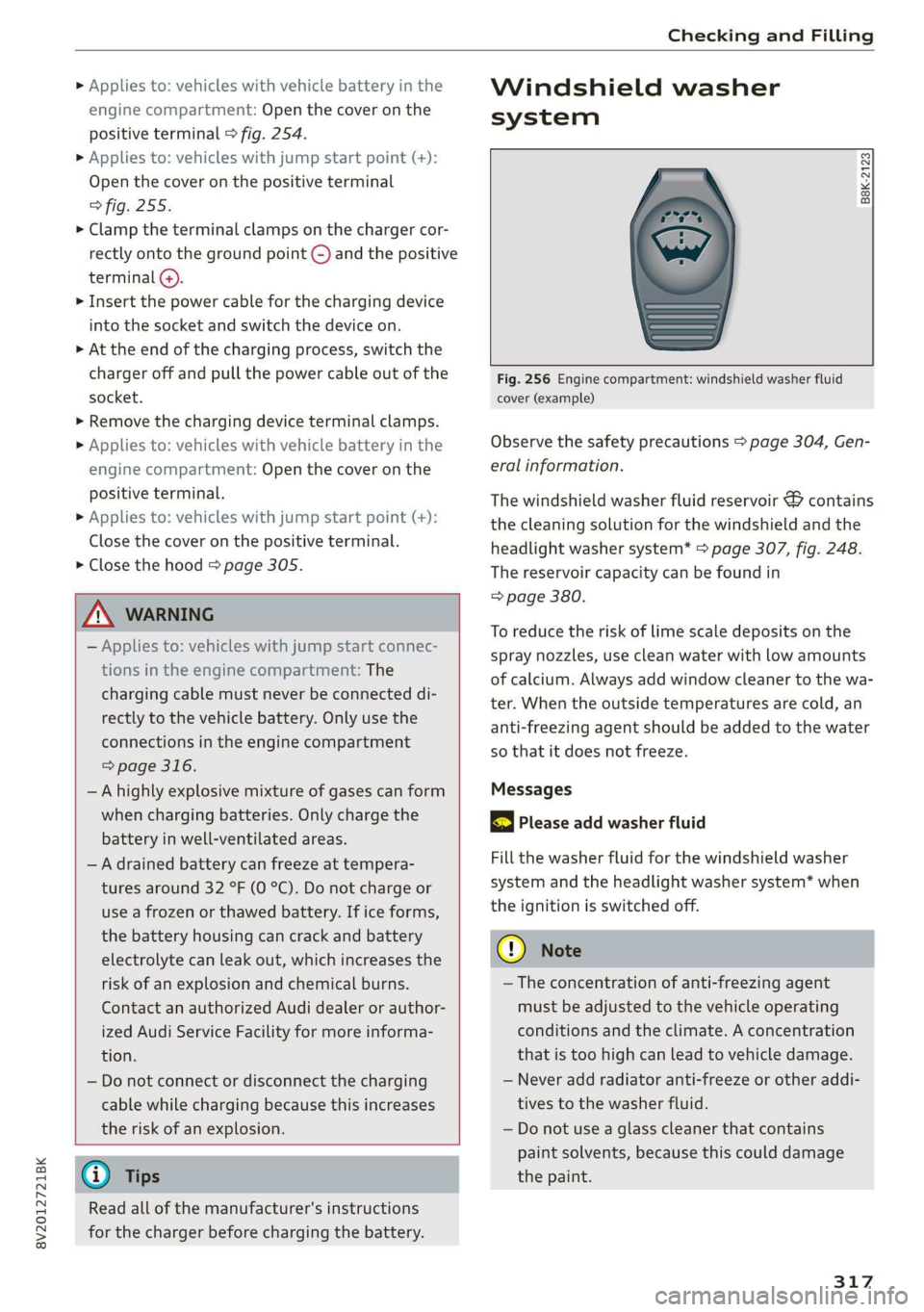
8V2012721BK
Checking and Filling
» Applies to: vehicles with vehicle battery in the
engine compartment: Open the cover on the
positive terminal > fig. 254.
> Applies to: vehicles with jump start point (+):
Open the cover on the positive terminal
> fig. 255.
> Clamp the terminal clamps on the charger cor-
rectly onto the ground point ©) and the positive
terminal @).
> Insert the power cable for the charging device
into the socket and switch the device on.
> At the end of the charging process, switch the
charger off and pull the power cable out of the
socket.
> Remove the charging device terminal clamps.
> Applies to: vehicles with vehicle battery in the
engine compartment: Open the cover on the
positive terminal.
> Applies to: vehicles with jump start point (+):
Close the cover on the positive terminal.
> Close the hood > page 305.
ZA WARNING
— Applies to: vehicles with jump start connec-
tions in the engine compartment: The
charging cable must never be connected di-
rectly to the vehicle battery. Only use the
connections in the engine compartment
=> page 316.
— A highly explosive mixture of gases can form
when charging batteries. Only charge the
battery in well-ventilated areas.
— A drained battery can freeze at tempera-
tures around 32 °F (0 °C). Do not charge or
use a frozen or thawed battery. If ice forms,
the battery housing can crack and battery
electrolyte can leak out, which increases the
risk of an explosion and chemical burns.
Contact an authorized Audi dealer or author-
ized Audi Service Facility for more informa-
tion.
— Do not connect or disconnect the charging
cable while charging because this increases
the risk of an explosion.
@) Tips
Read all of the manufacturer's instructions
for the charger before charging the battery.
Windshield washer
system
B8K-2123
Fig. 256 Engine compartment: windshield washer fluid
cover (example)
Observe the safety precautions > page 304, Gen-
eral information.
The windshield washer fluid reservoir & contains
the cleaning solution for the windshield and the
headlight washer system* > page 307, fig. 248.
The reservoir capacity can be found in
=> page 380.
To reduce the risk of lime scale deposits on the
spray nozzles, use clean water with low amounts
of calcium. Always add window cleaner to the wa-
ter. When the outside temperatures are cold, an
anti-freezing agent should be added to the water
so that it does not freeze.
Messages
gS Please add washer fluid
Fill the washer fluid for the windshield washer
system and the headlight washer system* when
the ignition is switched off.
@) Note
— The concentration of anti-freezing agent
must be adjusted to the vehicle operating
conditions and the climate. A concentration
that is too high can lead to vehicle damage.
— Never add radiator anti-freeze or other addi-
tives to the washer fluid.
— Do not use a glass cleaner that contains
paint solvents, because this could damage
the paint.
317
Page 366 of 400
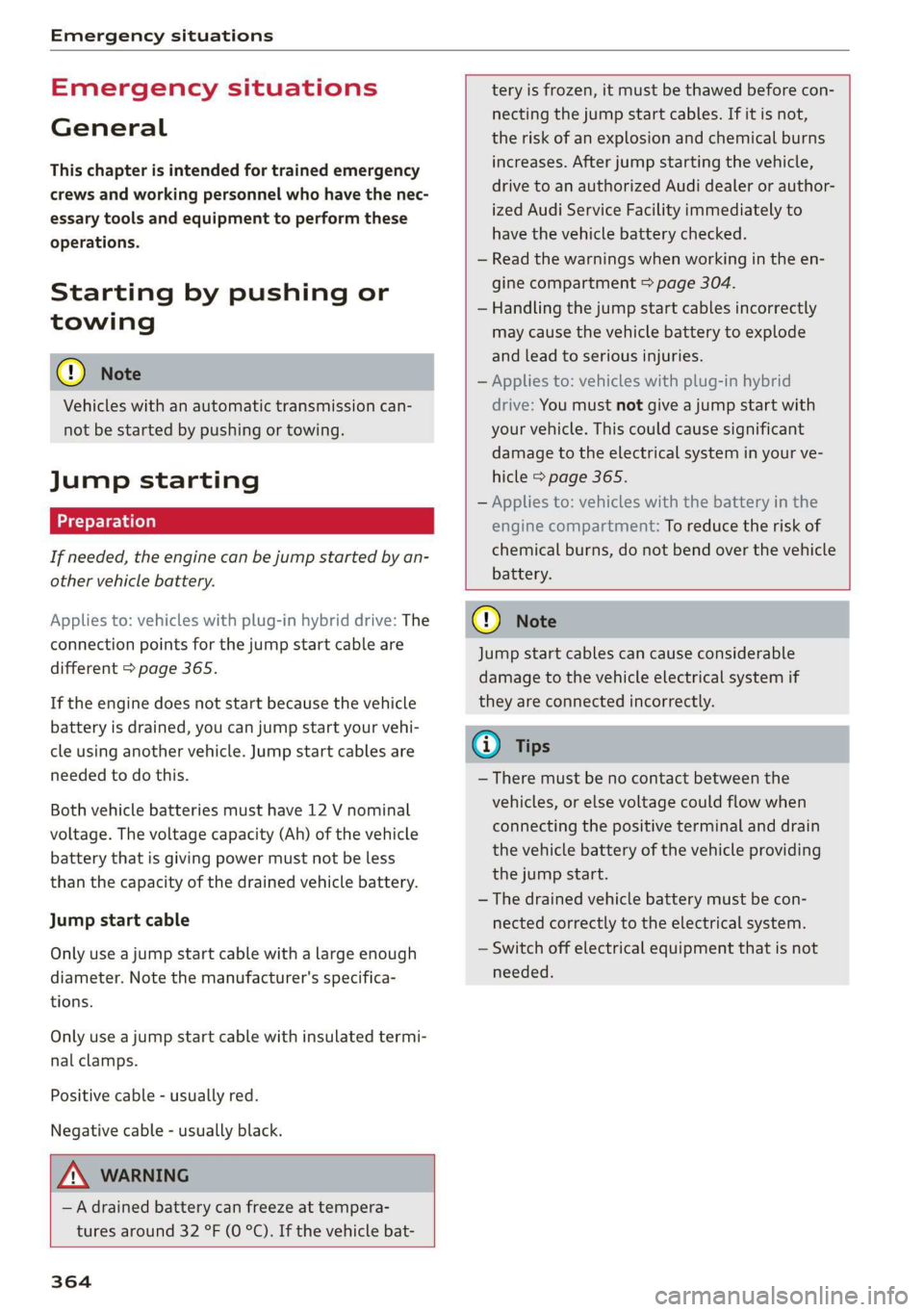
Emergency situations
Emergency situations
General
This chapter is intended for trained emergency
crews and working personnel who have the nec-
essary tools and equipment to perform these
operations.
Starting by pushing or
towing
@) Note
Vehicles with an automatic transmission can-
not be started by pushing or towing.
Jump starting
If needed, the engine can be jump started by an-
other vehicle battery.
Applies to: vehicles with plug-in hybrid drive: The
connection points for the jump start cable are
different > page 365.
If the engine does not start because the vehicle
battery is drained, you can jump start your vehi-
cle using another vehicle. Jump start cables are
needed to do this.
Both vehicle batteries must have 12 V nominal
voltage. The voltage capacity (Ah) of the vehicle
battery that is giving power must not be less
than the capacity of the drained vehicle battery.
Jump start cable
Only use a jump start cable with a large enough
diameter. Note the manufacturer's specifica-
tions.
Only use a jump start cable with insulated termi-
nal clamps.
Positive cable - usually red.
Negative cable - usually black.
A WARNING
— A drained battery can freeze at tempera-
tures around 32 °F (0 °C). If the vehicle bat-
364
tery is frozen, it must be thawed before con-
necting the jump start cables. If it is not,
the risk of an explosion and chemical burns
increases. After jump starting the vehicle,
drive to an authorized Audi dealer or author-
ized Audi Service Facility immediately to
have the vehicle battery checked.
— Read the warnings when working in the en-
gine compartment > page 304.
— Handling the jump start cables incorrectly
may cause the vehicle battery to explode
and lead to serious injuries.
— Applies to: vehicles with plug-in hybrid
drive: You must not give a jump start with
your vehicle. This could cause significant
damage to the electrical system in your ve-
hicle > page 365.
— Applies to: vehicles with the battery in the
engine compartment: To reduce the risk of
chemical burns, do not bend over the vehicle
battery.
@) Note
Jump start cables can cause considerable
damage to the vehicle electrical system if
they are connected incorrectly.
G@) Tips
— There must be no contact between the
vehicles, or else voltage could flow when
connecting the positive terminal and drain
the vehicle battery of the vehicle providing
the jump start.
— The drained vehicle battery must be con-
nected correctly to the electrical system.
— Switch off electrical equipment that is not
needed.
Page 367 of 400

8V2012721BK
Emergency situations
Jump start
Applies to: vehicles with plug-in hybrid drive
The
term "vehicle battery" refers to the 12 volt
battery in your vehicle.
rr B z
BS 3 & C3
1 = AT
Fig. 283 Engine compartment: connectors for a charger
and jump start cables
The vehicle is equipped with one vehicle battery
and one high-voltage battery.
If the vehicle battery is drained, it can be charged
with a charger or you can jump start the vehicle
using another vehicle's battery in the same way
as a conventional vehicle.
Read the information about charging the vehicle
battery > page 316 and for jump starting the ve-
hicle > page 364.
> Open the hood > page 305.
» Remove the fuse box cover (8) to access the
positive terminal (4) > page 307.
> Clamp the terminal clamps from the charging
device or jump start cable to the positive termi-
nal @) and to the body ground point @).
(@) Note
You must not give a jump start with your vehi-
cle. This could cause significant damage to
the electrical system in your vehicle.
A3 models: jump starting
Applies to: vehicles with conventional drive system
Both jump start cables must be connected in the
correct order.
Fig. 284 Engine compartment: connecting the jump start
cable
The vehicle battery is located on the left front
side of the engine compartment. Open the cover
to access the positive terminal of the vehicle bat-
tery. The procedure for connecting jump start ca-
bles that is described next is designed to help
jump start your vehicle.
Follow the information about the vehicle battery
> page 315.
Preparations
1. Read the following carefully > page 364,
Preparation.
2. Set the parking brake and place the selector
lever in the "P" position.
3. Turn the ignition and electrical equipment off
in both vehicles.
Connecting/disconnecting the jump start
cable
4. Fold the battery cover upward.
5. Clamp the end of the red jump start cable to
the positive terminal @ > fig. 284 on your
vehicle >(@) in Preparation on page 364.
6. Clamp the other end of the red jump start ca-
ble to the positive terminal 2) on the vehicle
battery providing the current.
7. Clamp the black end of the jump start cable
preferably to the ground point, or to the
negative terminal of the vehicle battery @)
on the vehicle providing the current.
365
>
Page 368 of 400
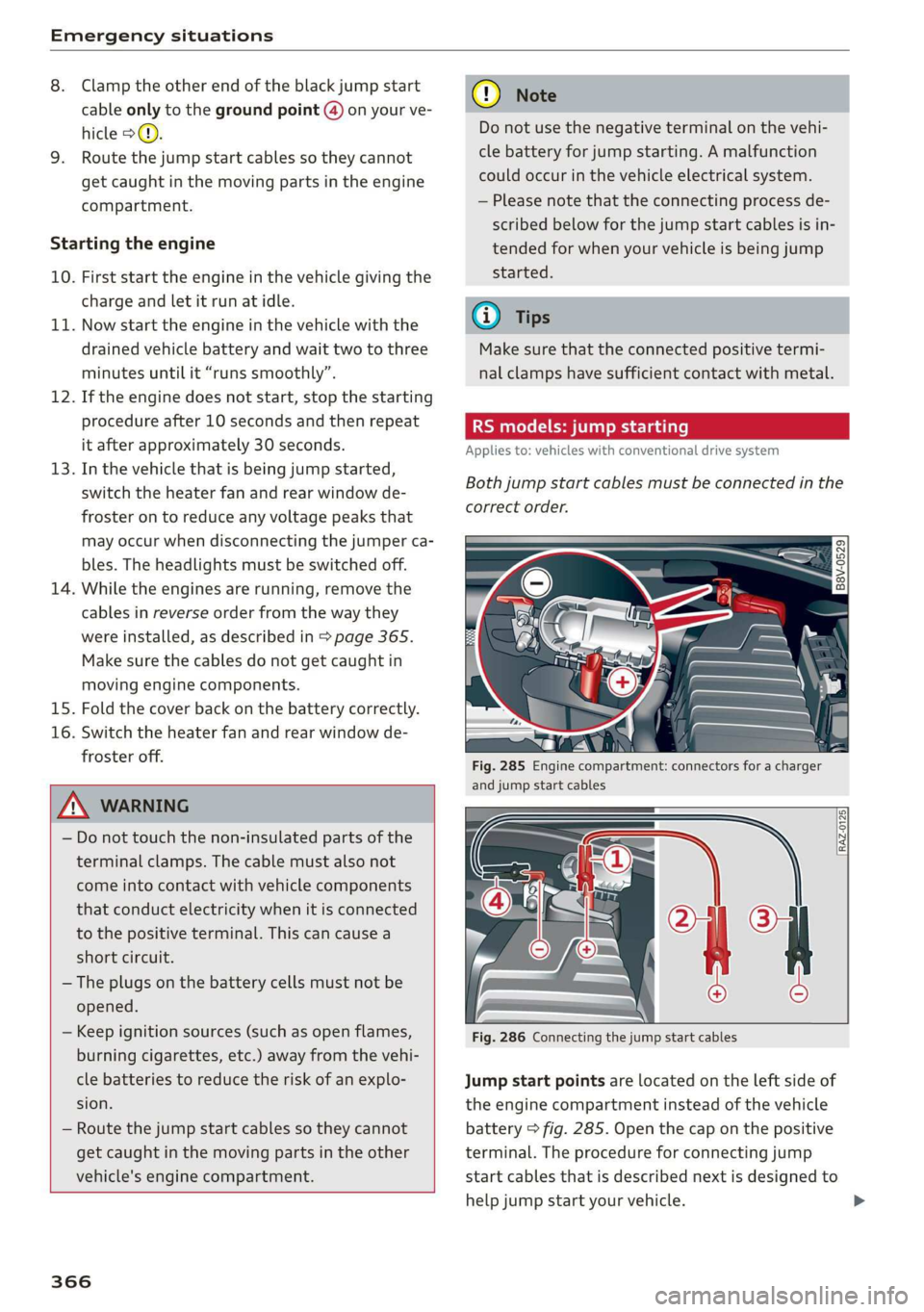
Emergency situations
8. Clamp the other end of the black jump start
cable only to the ground point @) on your ve-
hicle >@.
9. Route the jump start cables so they cannot
get caught in the moving parts in the engine
compartment.
Starting the engine
10. First start the engine in the vehicle giving the
charge and let it run at idle.
11. Now start the engine in the vehicle with the
drained vehicle battery and wait two to three
minutes until it “runs smoothly”.
12.
procedure after 10 seconds and then repeat
it after approximately 30 seconds.
13. In the vehicle that is being jump started,
switch the heater fan and rear window de-
froster on to reduce any voltage peaks that
may occur when disconnecting the jumper ca-
bles. The headlights must be switched off.
While the engines are running, remove the
cables in reverse order from the way they
were installed, as described in > page 365.
Make sure the cables do not get caught in
moving engine components.
Fold the cover back on the battery correctly.
Switch the heater fan and rear window de-
froster off.
14.
15. 16.
If the engine does not start, stop the starting
ZX WARNING
— Do not touch the non-insulated parts of the
terminal clamps. The cable must also not
come into contact with vehicle components
that conduct electricity when it is connected
to the positive terminal. This can cause a
short circuit.
— The plugs on the battery cells must not be
opened.
— Keep ignition sources (such as open flames,
burning cigarettes, etc.) away from the vehi-
cle batteries to reduce the risk of an explo-
sion.
— Route the jump start cables so they cannot
get caught in the moving parts in the other
vehicle's engine compartment.
366
C@) Note
Do not use the negative terminal on the vehi-
cle battery for jump starting. A malfunction
could occur in the vehicle electrical system.
— Please note that the connecting process de-
scribed below for the jump start cables is in-
tended for when your vehicle is being jump
started.
G) Tips
Make sure that the connected positive termi-
nal clamps have sufficient contact with metal.
RS models: jump starting
Applies to: vehicles with conventional drive system
Both jump start cables must be connected in th
correct order.
Fig. 285 Engine compartment: connectors for a charger
and jump start cables
Fig. 286 Connecting the jump start cables
ie
2 a rte}
S| 3 & co
Jump start points are located on the left side of
the engine compartment instead of the vehicle
battery > fig. 285. Open the cap on the positive
terminal. The procedure for connecting jump
start cables that is described next is designed to
help jump start your vehicle.
>
Page 369 of 400
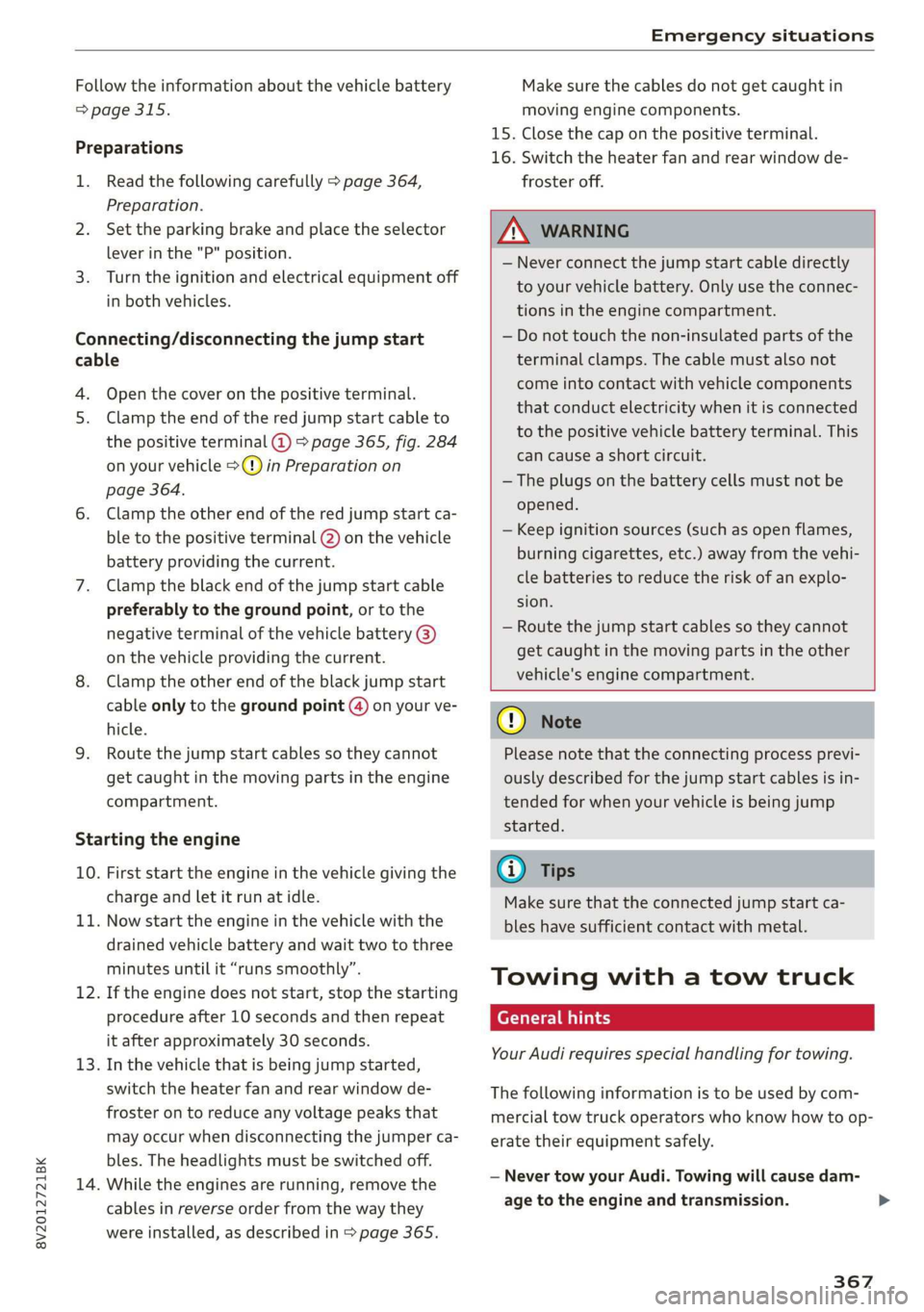
8V2012721BK
Emergency situations
Follow the information about the vehicle battery
=> page 315.
Preparations
1. Read the following carefully > page 364,
Preparation.
2. Set the parking brake and place the selector
lever in the "P" position.
3. Turn the ignition and electrical equipment off
in both vehicles.
Connecting/disconnecting the jump start
cable
4. Open the cover on the positive terminal.
5. Clamp the end of the red jump start cable to
the positive terminal @ > page 365, fig. 284
on your vehicle >@) in Preparation on
page 364.
6. Clamp the other end of the red jump start ca-
ble to the positive terminal (2) on the vehicle
battery providing the current.
7. Clamp the black end of the jump start cable
preferably to the ground point, or to the
negative terminal of the vehicle battery @)
on the vehicle providing the current.
8. Clamp the other end of the black jump start
cable only to the ground point (4) on your ve-
hicle.
9. Route the jump start cables so they cannot
get caught in the moving parts in the engine
compartment.
Starting the engine
10. First start the engine in the vehicle giving the
charge and let it run at idle.
11. Now start the engine in the vehicle with the
drained vehicle battery and wait two to three
minutes until it “runs smoothly”.
12. If the engine does not start, stop the starting
procedure after 10 seconds and then repeat
it after approximately 30 seconds.
13. In the vehicle that is being jump started,
switch the heater fan and rear window de-
froster on to reduce any voltage peaks that
may occur when disconnecting the jumper ca-
bles. The headlights must be switched off.
14. While the engines are running, remove the
cables in reverse order from the way they
were installed, as described in > page 365.
Make sure the cables do not get caught in
moving engine components.
15. Close the cap on the positive terminal.
16. Switch the heater fan and rear window de-
froster off.
ZA\ WARNING
— Never connect the jump start cable directly
to your vehicle battery. Only use the connec-
tions in the engine compartment.
— Do not touch the non-insulated parts of the
terminal clamps. The cable must also not
come into contact with vehicle components
that conduct electricity when it is connected
to the positive vehicle battery terminal. This
can cause a short circuit.
— The plugs on the battery cells must not be
opened.
— Keep ignition sources (such as open flames,
burning cigarettes, etc.) away from the vehi-
cle batteries to reduce the risk of an explo-
sion.
— Route the jump start cables so they cannot
get caught in the moving parts in the other
vehicle's engine compartment.
@) Note
Please note that the connecting process previ-
ously described for the jump start cables is in-
tended for when your vehicle is being jump
started.
(i) Tips
Make sure that the connected jump start ca-
bles have sufficient contact with metal.
Towing with a tow truck
General hints
Your Audi requires special handling for towing.
The following information is to be used by com-
mercial tow truck operators who know how to op-
erate their equipment safely.
— Never tow your Audi. Towing will cause dam-
age to the engine and transmission. >
367
Page 387 of 400

8V2012721BK
Index
Dynamic volume
refer to System volume........---.00-5 235
E
E-mail...............0000 000 c eee eee 177
eco mode (climate control system)......... 66
Economical route wives so aicava a a wsnsens a 6 aienaie 197
EDL
refer to Electronic Differential Lock....... 93
EDR
refer to Event Data Recorder........... 371
Efficiency program... ... eee eee eee eee 23
Electrical system. .......2.-.0 ee eee eee 314
Electromechanical parking brake.......... 87
Electronic Differential Lock............... 94
Electronic immobilizer..............00005 26
Electronic Stabilization Control............ 93
Embedded)SIM Cat wavy. s waves » x eee 3 5 ee 183
Emergency assistance ............0 eee 348
Emergency braking function.............. 87
Emergency flashers.............0.000005 45
Emergency mode...................2005 77
Emergency operation
DOOrs 0... eee eee 30
Fuebfillerdoor's » = sry : 4 sews s eae s pee 301
Luggage compartment lid............... 32
Panoramic glass roof................-. 35
Emergency starting..................-. 364
Emissions control system..............- 303
Energy CONSUMENS « « sick 4 este oo weirs oo ave 22
Energy management............eceeeeee 82
Energy recovery
refer to Recuperation.................. 78
Engine
Breakingin.............2..2.02020020005 78
GCoGlaiitiowen: « 2 wage « 2 germs gz eee ge EE EE 311
Emerqeney:stops « sesscc x 2 same a v answes vv ase 71
Jump starting ........ cee cece eee eee 364
Jump starting (plug-in hybrid drive)...... 365
Start/Stop'SySteM sei os wes eo sosnene o + wore 83
Starting and stopping.................. 71
Engine braking effect
refer to Recuperation..............000. 78
Engine compartment
Opening and closing the hood.......... 305
OVERVIEW ecu 3 2 cows « @ eos ¢ eae go re 307
Safety precautions.................04. 304
Engine data
refer to Sport displays............000005 24
Engine oil
Adding ......... 00. c cee ee eee eee ee 307
CHANGING ox « « caw « paawy s mews oo Romy s & 310
Checking oil:leveli. . « csscie «0 vce wn meee a 307
Consumption...........0..-0.0 eee eee 307
DiPStick:: s sees = x ween 2 2 Bowe 2 ze eees Bae 307
Indicator light & cscs. x x wow xo coon ea menos 308
Replacement interval................. 318
Temperature display................0.. 23
Engine start system. ..............0..0-. 73
Engine stop
Goastings: « sss + ¢ sees + ¢ ceeie oo ews = 78, 83
Enhanced VieW « ase > mee s soem es eee ee 19
Entering characters/numbers (speller)... .. 153
Entering letters (speller)................ 153
Entertainment sliding menu............. 151
Entry/exit lighting. ............. 0... eee 45
Entry assistance
refer to Seats... 2... eee ee 55
Environment
Unleaded gasoline................205. 298
EPB
refer to Electromechanical parking brake.. 87
eSIM
refer to Embedded SIM card............ 183
Event: Data Recorder's « «sci. e s sxcciws 2 a eon © 371
Exterior lighting: < swe « = sews sy eee = 5 oes 43
Exterior MUrrOtScs: = = seus « 2 ees ae ween eo: 47
FOldin Qian 3 5 soane vx wens 2 ¥ anewens oo shea a 2 ae 47
Folding settings................0e ee eee 29
External voice operation................ 168
F
Factory default settings
Multi Media Interface................. 231
Fader (sound) ...........- 0c eee eee eee ee 234
Fastening
Booster seats..............0-00-0000. 287
Convertible child safety seats........... 285
Infant seats.......... 0... cee eee eee ee 284
Page 389 of 400

8V2012721BK
Index
HFP
refer to Hands Free Profile............. 169
High-voltage battery.................00. 96
Audi e-tron compact charging system.... 105
GharGin Giese 2 vas o wens ey wees ae eeee 2 111
Not running for long periods of time..... 100
High-voltage’systemtiein x 0 consis se sssinos 6 0 vense 96
High D@aIBics <2 ewes oe weave oe muse a v immeew & e 44
High beam assistant................00. 44
Hillidescemticomtrols. wiscees oo scaessn m » sxmene o 6 au 89
FW HolGhassist cies wa owen v a oven oe aaron a 60 74
Homeraddressis « sissies 2s wears a 0 sews os 191,196
HOH « scene 5 & coven 5 2 eases ¥ & HER 5 EEG oF RE 8
Hotspot
FEFEP EOWA Lis « seewevee & wesw 4 ¥ movin 187,214
How are child restraint system anchors relat-
ed to child safety.................0000. 292
How many airbags does my vehicle have?.. 260
How safety belt pretensioners work....... 252
I
Idle
refer to Gears. 1.2... ee eee eee ee 75
Ignition
Switching on and off...............200- 71
Imbalance (wheels).................5-. 328
Immobilizer
refer to Electronic immobilizer........... 26
Important things to do before driving..... 237
Importing and exporting (contacts)....... 179
Improperly worn safety belts............ 251
Indicator lights............. 0... c eee eee 10
Airbag system... cee eee eee eee 265
PASSENGER AIR BAG OFF .............. 265
INTANtSEAES seus: xs eens & 2 wate ose a oe 284
Input
Using the! MMEtOU GH sii «= ssc o svacane ov ove 149
Using the speller................-.00. 153
Input level (media)... 0... 0.0. cee ee eee 222
Inspectiontinternvales « sui ¢ wemin a 2 ames a sam 318
Installing the upper tether strap on the an-
Chorage.... eee eee eee eee 295
Instrument clusters « csiscss sa savas a a avesie 0 ¥ ae 14
Cleaning.......... cece ee eee eee 345
Failure: » s esau ¢ 2 away 4: eeu s ReeR ae EER 14
Service interval display................ 318
Instruments
Adjusting illumination.................. 47
Interference-Causing Equipment Standard
(IGES)"s sass 2 § saws 4 3 Sano ¢ 4 SaiOR ES BORE EE 378
Interior lighting. .......... cee eee eee 46, 47
Interior monitoring.................5005 30
International travel..............00 000 187
Internet
refer to connect..........0e eee eee eee 182
Internet radio... eee eee eee 215
Interval mode (windshield wipers) ......... 49
iPhone
refer to Audi music interface........... 217
iTunes tagging.......... eee eee eee eae 206
J
Jukebox... cee eee 213
JUMAPISEALE cesnccs « sxc & 2 corners 6 x ose wo ae 365
JUmpistartin pes x « wean x 3 seems oo ssen 364, 365
K
ROY. socuass a 0 imines @ 2 anes 5 0 eRe 2B eRe & BERN 26
Convenience opening and closing......... 34
Key
replacement............0eeceeeeee 26
Replacing the battery.................. 27
Unlocking and locking............... 27,28
Rick=GOwins. « sss uo semaens = a sansime » s aecowne © 7 ence 76
Kineeraitbagsi: s scsiss s 3 sae oi maven 9 6 mero 6 5 269
Description. ....... 0.0.0. cece eee eee 269
How they Work: «2 sewn x x agama o wee cog 270
Important safety instructions.......... 271
L
Lane assist
refer to Audi active lane assist.......... 128
Bap TIM|R. & sews & a arenes 6 ¥ swine we wanes we oun L117
LATCH ss «a ovacans « 3 anmews oo asonast a a omuiw « arama a 292
Description............0..0..0..000. 293
Installing a child restraint............. 293
LOGAtION « sswsows 6 2 crocs yo cares wo ame Yo ane 292
Mounting and releasing the anchorage
hook... eee eee eee 293
Launch Control. ...........2..220- eee 77
Leather care andcleaning............... 345
Left control button..............e seen eee 18